Cedar key Small Boat Gathering - 2013
Cedar key - Part II
Sunday
We got up and had a full day of sailing on the agenda and a more ambitious plan. I got the boat ready which was much easier than normal since I only had to hoist sails. The winds were a bit high so we opted for just the jib and mizzen. I pulled up the anchor. It was caked in mud that would not wash off. I pulled it up and scraped the mud off with my hands. It smelled like rotten eggs. After we got away from the harbor I put a bucket in the water and washed my hands off. I dumped the rest on the anchor and stern deck where it sat. Then I stowed the anchor.
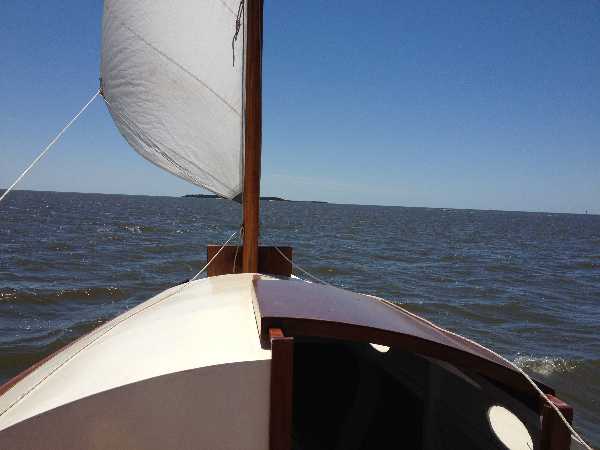
We sailed past Atseno Otie Key and toward what we thought was Seahorse Key. But the more I think about it now it was Snake Key. This view reminded me of Gilligans Island. But we couldn't land here at all. Seahorse is a protected wildlife refuge and is completely off limits from March to June so the wildlife isn't disturbed during nesting season. Also the chart showed extensive mud flats around the island making approach and departure difficult at low tide.
We sailed out fairly close to Seahorse Key. Then we tacked. The plan was to sail south of Atseno Otie Key and round up to land on the beach. The tides were really going out though and sandbars appeared. First the centerboard dragged. The the rudder started dragging as I tried to feel my way past the sandbars. Next I decided that this really wasn't very smart and turned around.
I started thinking of past situations where I got in trouble and ended up staying out way past the planned return time. I didn't want to do that here.
So moving to plan "B" we sailed back the way we came out to about half way to Seahorse Key. There were more sandbars. Finally I saw the channel just a bit north west of our location and sailed there. We sailed in via the channel for a couple of miles to get back to the deep water between the mainland and Atseno Otie Key.
We then turned toward the island and started to land near where we landed Saturday.
I proceeded to beach the boat, only the water here was still too shallow. So I backed off a bit and set the anchor. But the boat was banging on the bottom a bit. It was 4pm and low tide was about 6pm and almost a foot lower. I decided to get the boat further out so that there was at least a foot of water under her rudder. I then set the stern anchor and payed her out as I motored in a bit. Then I tied it off. I ran the bow anchor up as close to the shore as I could and set it in the water. This arrangement was more like anchoring out than beaching.
We got off and waded ashore. A guy came up and asked me if I was searching for gold. I said that sailing over in my own boat and exploring this island on nobody's schedule but my own was the "gold". We all chatted for a while.
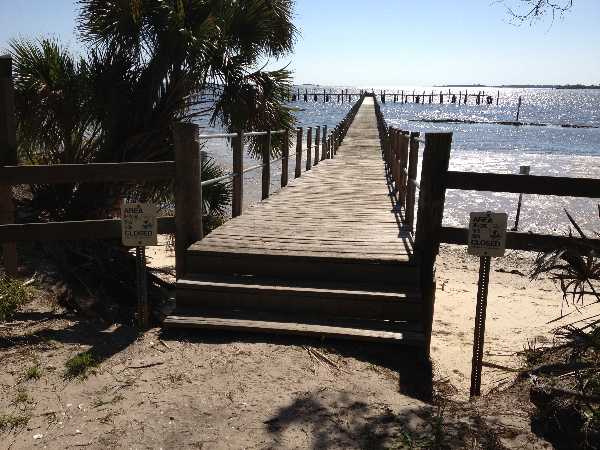
We then got on the trail to the interior of the island. Here are signs indicating that the beach on either side of the dock are off limits but the dock itself is open to the public. In many places there were such signs posted.
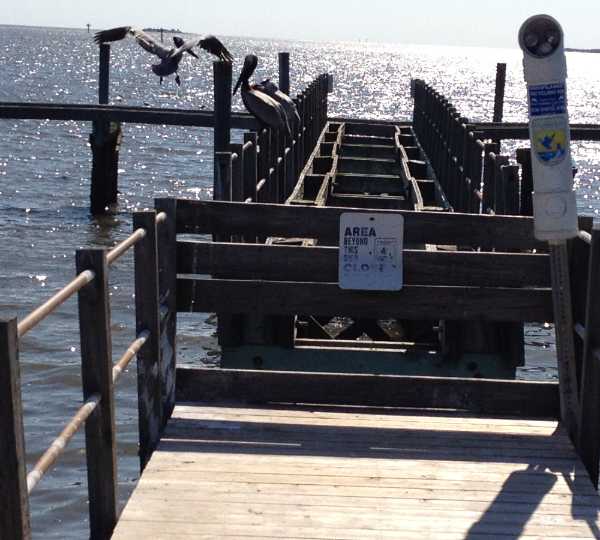
The pelicans are doing their thing.
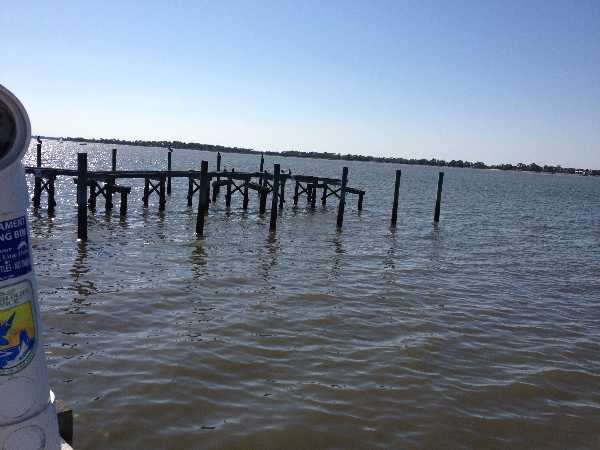
The way this dock was set up suggests that this was once built as a marina. Given that Atseno Otie Key was once slated for a residential development this doesn't seem too surprising.
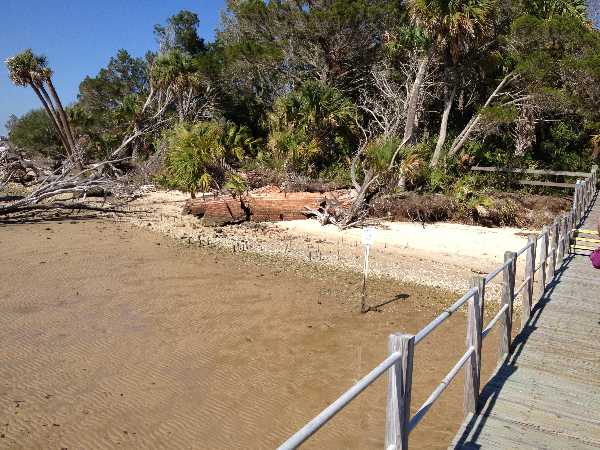
We found some of the ruins of the Eberhard Faber pencil factory.

We hiked further down the trail to a cemetary.
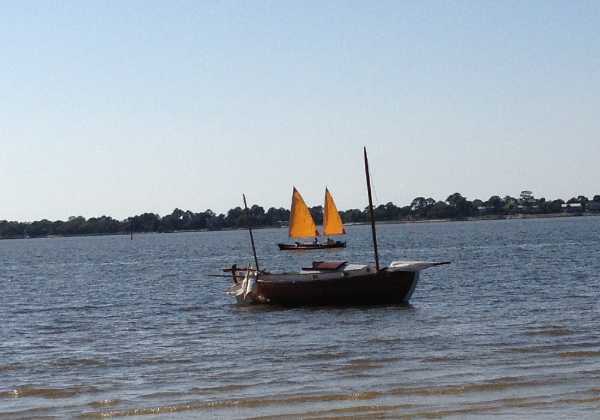
About 5:45 or so we waded back to the boat. We pulled up the bow anchor and stowed it. It was still under water. We then climbed aboard. I pulled up the stern anchor and used the motor to back away from the beach. Only this wasn't working too well. We were already aground. So the only thing to do was to go back down the ladder, go to the bow and push away from shore. Then I swung the boat around and went to the stern to push further into deeper water. Debbie steered. Once she got moving freely I waded to the ladder and climbed back aboard.
We easily sailed back to the harbor and beached the boat.
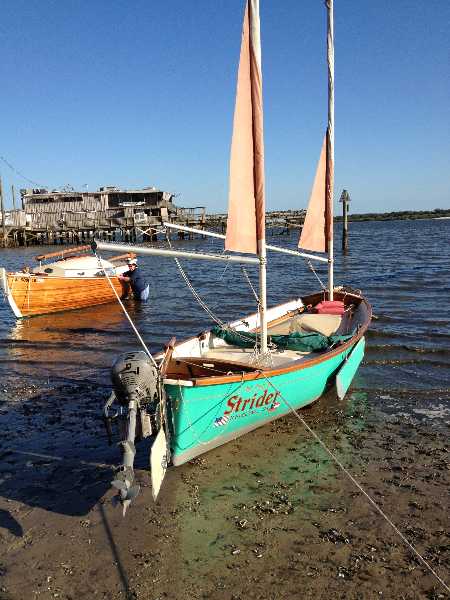
I stepped off the ladder into knee deep nasty muck just like what I scraped off the anchor earlier. Then Debbie had to step in it. She sunk even deeper. With superhuman strength she managed to wade ashore without losing her shoes. There was no way around this. Sometimes this is what it takes. I was told later that if we hadn't cleaned this mud off right away that we could end up with sores.
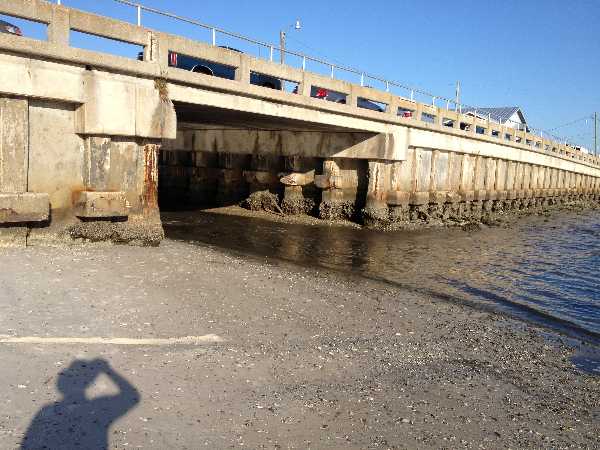
Since the sailing was done I debated whether to put the boat on the trailer at night or wait until the next day. The water under the low bridge was really low. I waded over there and measured it. It was just past knee deep in the middle. This would have been just barely adequate for the Elver. A few minutes later a boat pushed through. Then my cell phone battery died so no more pictures.
We decided to defer retrieving the boat until the next day. The tides were at their forecast lowest. As long as the boat was in enough water to freely float now she was good to go. Allowing the boat to settle into this deep mud on an extremely low tide seems a really bad idea since I reckon she could possibly become stuck to the bottom like a suction cup.
We went back to the hotel and cleaned up then made it to the Island Restaurant for a really good meal.
Monday
The next morning the tide was up so I waded into much nicer sand to get the boat. The batteries were nearly depleted. On the way to the ramp I realized that I needed to do something about the trolling motor linkage. I have to look back to remember which way to turn the handle for reverse and forward. If I don't then sometimes I turn it wrong and mess up my maneuvering. This is just one of a long list of tweeks and adjustments that need to be made to the boat.
As I got the boat cleaned up someone came by for just a few more minutes of Wooden Boat Show. I was happy to oblige. After that A wonderful weekend of messing about in boats came to an end.
We then headed back to the cold, wet and storms of home. A cat bucket sitting in the back yard accumulated about 9" of water from the rain at my house.